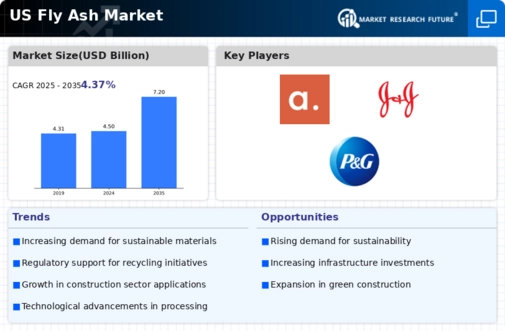The US Fly Ash Market is characterized by a robust and dynamic competitive landscape, driven by an increasing demand for sustainable construction materials and a growing emphasis on reducing environmental impacts associated with cement production. Fly ash, a byproduct of coal combustion, has gained significant traction in the construction segment for its benefits in enhancing concrete durability, reducing permeability, and improving workability. The market is populated with numerous players who engage in extensive research and innovation to develop high-quality fly ash products optimized for various applications.
As concrete producers and construction companies look to meet stricter regulatory standards and increase their sustainability practices, competition among suppliers intensifies. Companies are focusing on strategic partnerships, expanding their production capabilities, and leveraging technological advancements to enhance their market position and ensure a steady supply of fly ash.Titan America has established itself as a formidable player in the US Fly Ash Market due to its wide-ranging operations across the southeastern United States, which not only optimize logistics and supply chain efficiencies but also enhance its customer reach.
The company’s strengths lie in its commitment to high-quality fly ash products, which are essential for infrastructure projects and residential constructions. Titan America capitalizes on its integrated business model, which enables it to produce fly ash as a byproduct of its cement manufacturing. This vertical integration ensures a consistent quality of fly ash while minimizing environmental impacts.
The company's focus on innovation and sustainable practices has enabled it to adapt to changing regulations and customer preferences, thus solidifying its presence in the market and enhancing its competitive edge.Ash Grove Cement is another significant entity within the US Fly Ash Market, known for its commitment to producing superior construction materials while promoting environmental sustainability. The company's primary products include cement and fly ash, catering to various construction sectors across the US. Ash Grove Cement's key strengths involve its extensive distribution network, which facilitates timely product delivery to customers, and its strong reputation for reliability and quality.
Furthermore, the company actively engages in mergers and acquisitions, allowing it to expand its operational footprint and diversify its offerings. By integrating fly ash into its product portfolio, Ash Grove Cement not only enhances the overall performance of its cement products but also positions itself favorably in the market as more construction companies look to incorporate recycled materials. The strategic focus on developing reliable supply chains and increasing production capacity bolsters its competitive stance within the US fly ash landscape.














Leave a Comment